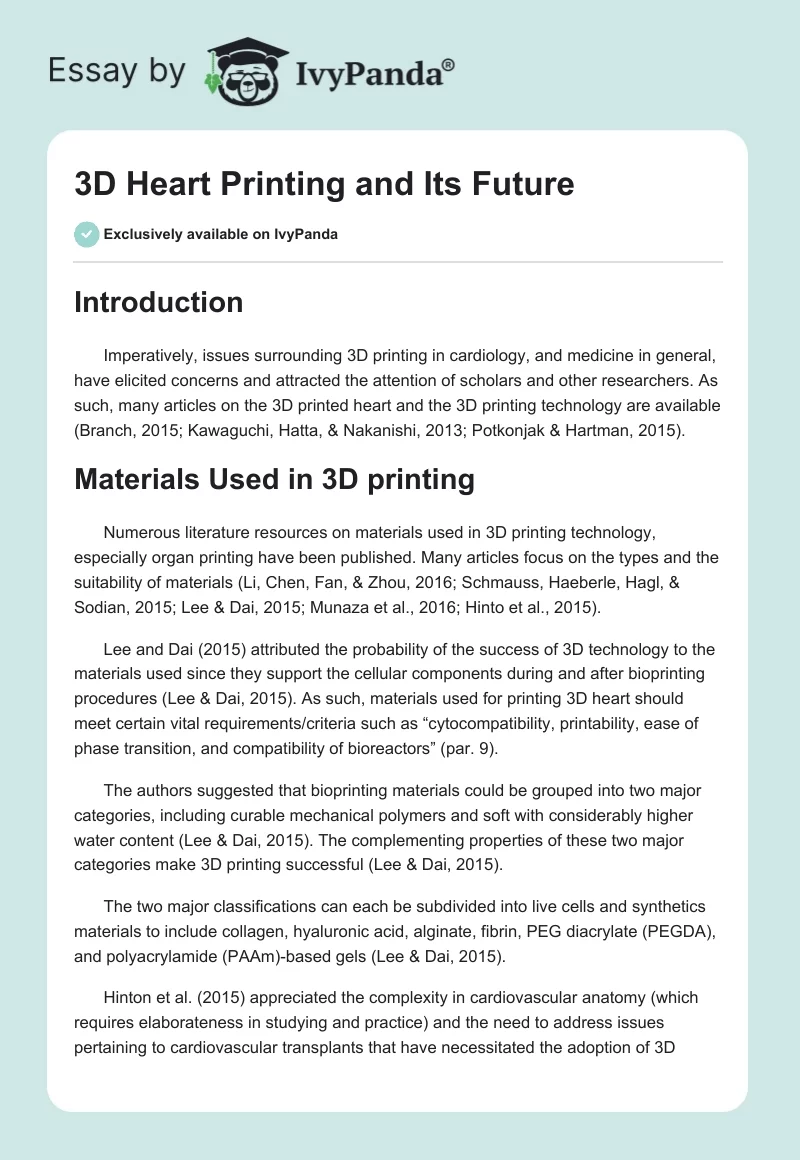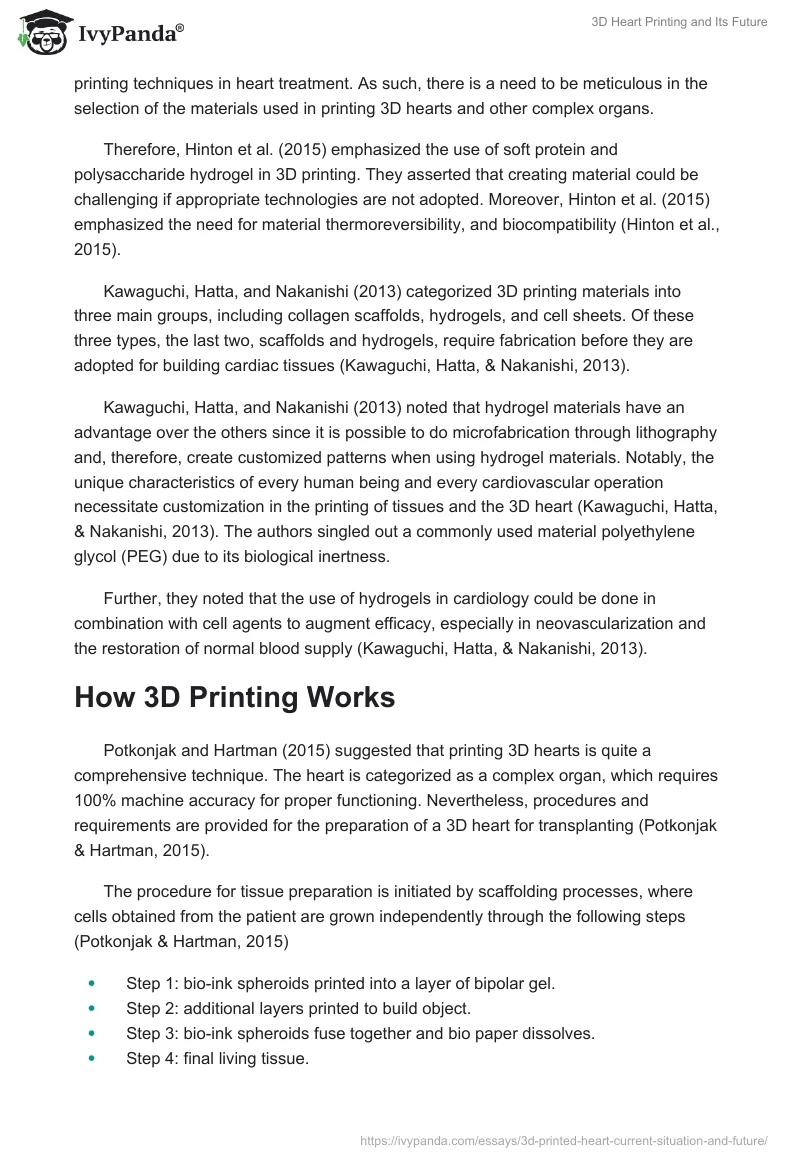Introduction
Imperatively, issues surrounding 3D printing in cardiology, and medicine in general, have elicited concerns and attracted the attention of scholars and other researchers. As such, many articles on the 3D printed heart and the 3D printing technology are available (Branch, 2015; Kawaguchi, Hatta, & Nakanishi, 2013; Potkonjak & Hartman, 2015).
Materials Used in 3D printing
Numerous literature resources on materials used in 3D printing technology, especially organ printing have been published. Many articles focus on the types and the suitability of materials (Li, Chen, Fan, & Zhou, 2016; Schmauss, Haeberle, Hagl, & Sodian, 2015; Lee & Dai, 2015; Munaza et al., 2016; Hinto et al., 2015).
Lee and Dai (2015) attributed the probability of the success of 3D technology to the materials used since they support the cellular components during and after bioprinting procedures (Lee & Dai, 2015). As such, materials used for printing 3D heart should meet certain vital requirements/criteria such as “cytocompatibility, printability, ease of phase transition, and compatibility of bioreactors” (par. 9).
The authors suggested that bioprinting materials could be grouped into two major categories, including curable mechanical polymers and soft with considerably higher water content (Lee & Dai, 2015). The complementing properties of these two major categories make 3D printing successful (Lee & Dai, 2015).
The two major classifications can each be subdivided into live cells and synthetics materials to include collagen, hyaluronic acid, alginate, fibrin, PEG diacrylate (PEGDA), and polyacrylamide (PAAm)-based gels (Lee & Dai, 2015).
Hinton et al. (2015) appreciated the complexity in cardiovascular anatomy (which requires elaborateness in studying and practice) and the need to address issues pertaining to cardiovascular transplants that have necessitated the adoption of 3D printing techniques in heart treatment. As such, there is a need to be meticulous in the selection of the materials used in printing 3D hearts and other complex organs.
Therefore, Hinton et al. (2015) emphasized the use of soft protein and polysaccharide hydrogel in 3D printing. They asserted that creating material could be challenging if appropriate technologies are not adopted. Moreover, Hinton et al. (2015) emphasized the need for material thermoreversibility, and biocompatibility (Hinton et al., 2015).
Kawaguchi, Hatta, and Nakanishi (2013) categorized 3D printing materials into three main groups, including collagen scaffolds, hydrogels, and cell sheets. Of these three types, the last two, scaffolds and hydrogels, require fabrication before they are adopted for building cardiac tissues (Kawaguchi, Hatta, & Nakanishi, 2013).
Kawaguchi, Hatta, and Nakanishi (2013) noted that hydrogel materials have an advantage over the others since it is possible to do microfabrication through lithography and, therefore, create customized patterns when using hydrogel materials. Notably, the unique characteristics of every human being and every cardiovascular operation necessitate customization in the printing of tissues and the 3D heart (Kawaguchi, Hatta, & Nakanishi, 2013). The authors singled out a commonly used material polyethylene glycol (PEG) due to its biological inertness.
Further, they noted that the use of hydrogels in cardiology could be done in combination with cell agents to augment efficacy, especially in neovascularization and the restoration of normal blood supply (Kawaguchi, Hatta, & Nakanishi, 2013).
How 3D Printing Works
Potkonjak and Hartman (2015) suggested that printing 3D hearts is quite a comprehensive technique. The heart is categorized as a complex organ, which requires 100% machine accuracy for proper functioning. Nevertheless, procedures and requirements are provided for the preparation of a 3D heart for transplanting (Potkonjak & Hartman, 2015).
The procedure for tissue preparation is initiated by scaffolding processes, where cells obtained from the patient are grown independently through the following steps (Potkonjak & Hartman, 2015)
- Step 1: bio-ink spheroids printed into a layer of bipolar gel.
- Step 2: additional layers printed to build object.
- Step 3: bio-ink spheroids fuse together and bio paper dissolves.
- Step 4: final living tissue.
Munaza et al. (2016) appreciated that 3D printing technology has revolutionized human history, especially in medicine. They linked the introduction of 3D printing to Charles Hull in late 1980. Later in the early 20th century, technology would start to materialize allowing the fabrication of materials in diverse fields, including in clinical implantation (Munaza et al., 2016).
Munaza et al. (2016) suggested a three-stage model of 3D organ printing. The three stages include pre-processing, processing, and post-processing stages. The initial stage, pre-processing, is comprised of the creation of a heart blueprint from MRI (Munaza et al., 2016). Information is then converted into direct instruction software for the printing hardware (Munaza et al., 2016).
The real printing is done in the second phase, which involves the preparation of bio-ink, cell sorting, cell propagation, and cell differentiation (Munaza et al., 2016). The last phase, post-processing, involves pertinent procedural methods aimed at converting the printed product into a working tissue-engineered organ, which can be used as a clinical implant (Munaza et al., 2016).
Ventola (2014) suggested that even though the use of laser-based 3D organ printing is possible, most bioprinting systems adopt inkjet-based/or extrusion-based techniques (Ventola, 2014). The inkjet-based technique deposits bio-ink onto a substrate depending on the digital instruction to create 3D printed organs through the following steps (Ventola, 2014).
- Creation of an organ blueprint.
- Generation of the printing process plan.
- Isolation of stem cells.
- Cell differentiation and specification.
- Preparation of bio-ink reservoirs and supporting materials for printing.
- Printing.
- Using a bioreactor on the printed organ before using it for transplantation.
Challenges/Limitations and Issues in 3D Heart Printing
Branch (2015) appreciated that although 3D printing is a milestone in medicine, it is faced with a number of challenges. First, technology is affected by the unique nature of each patient. Every human body is unique with different characteristics from others. As such, a certain 3D printed heart may be appropriate for one body but unsuitable for another (Branch, 2015). Therefore, 3D hearts should be individualized and almost similar to the replaced organ.
Moreover, 3D printing technology is flawed since it is limited in the creation of specific details down to the cell level (Branch, 2015).
Li, Chen, Fan, Zhou (2016) appreciated that although bioprinting technology has drawn considerable attention for producing scaffolds, cells, tissues, and organs and the many positive aspects, it faces many challenges, especially in the printing complex organs. As such, printing complex organs such as the human heart still face numerous hurdles.
Moreover, Li et al. (2016) raised the concern of the requirements such as the assembling of layer-by-layer with bio-glue in the creation of complex organs such as the human heart. Moreover, there are huge impediments, especially on the provision of suitable bio-inks that have the required compatibility, mechanical robustness, and regulatory issues (Li et al., 2016).
Ventola (2014) put considerable emphasis on issues and concerns surrounding 3D printing in healthcare. First, there are concerns about the technology being overhyped and stakeholders having unrealistic expectations resulting in over-projections (Ventola, 2014).
Second safety and security concerns have been raised, especially because the technology can fall into the wrong hands, a scenario that can be detrimental (Ventola, 2014). As such, some stakeholders have suggested banning of 3D printing. Third, patent and copyright concerns are raised where the use of 3D printed organs for commercial, personal, or non-profit distribution is said to face licensing issues and loopholes. Lastly, 3D printing faces regulatory concerns where widespread use and production of 3D printed organs would be hindered by regulatory frameworks (Ventola, 2014).
The Future of the 3D Printed Heart and the Associated Technology
Currently, 3D printing has not only been successful in surgical implants and prosthetics but also applicable and useful in cardiology and cardiovascular surgery. However, the printing of complex organs such as a 3D printed heart, which can be used to replace a human heart, is yet to be realized (Lee & Dai, 2015; Potkonjak & Hartman, 2015). Therefore, realizing this goal is part of the future projections (Potkonjak & Hartman, 2015; Deferm, Meyns, Vlasselaers, & Budts, 2016).
In addition, in situ printing of internal organs is expected to be done when all the challenges and concerns are comprehensively addressed (Lee & Dai, 2015; Potkonjak & Hartman, 2015; Li et al., 2016). Furthermore, it is worth noting that the future of 3D printing is dependent on numerous factors, including research, funding, stakeholders’ participation among other pertinent issues (Potkonjak & Hartman, 2015; Ventola, 2014; Li et al., 2016).
References
Branch, C. (2015). 3D printing in healthcare. The Review: A Journal of Undergraduate Student Research, 16(3), 1-4.
Deferm, S., Meyns, B., Vlasselaers, D., & Budts, W. (2016). 3D-printing in congenital cardiology: from flatland to spaceland. Journal of Clinical Imaging Science, 6(8),. Web.
Hinton, T. J., Jallerat, Q., Palchesko, R. N., Park, J. H., Grodzicki, M. S., Shue, H.-J.,… Feinberg, A. W. (2015). Three-dimensional printing of complex biological structures by freeform reversible embedding of suspended hydrogels. Science Advances, 1(9), e1500758. Web.
Kawaguchi, N., Hatta, K., & Nakanishi, T. (2013). 3D-culture system for heart regeneration and cardiac medicine. BioMed Research International, 2013 (2013), 1-6. Web.
Lee, V., & Dai, G. (2015). Three-dimensional bioprinting and tissue fabrication: prospects for drug discovery and regenerative medicine. Dove press, 2015(1), 23-35. Web.
Li, J., Chen, M., Fan, X., & Zhou, H. (2016). Recent advances in bioprinting techniques: approaches, applications and future prospects. Journal of Translational Medicine, 14(2016), 271. Web.
Munaza, A., Vadivelub, R. K., Johnb, J. S., Bartonc, M., Kamblea, H., & Nguyen, N.-T. (2016). Three-dimensional printing of biological matters. Journal of Science: Advanced Materials and Devices, 1(1), 1-17. Web.
Potkonjak, A., & Hartman, A. (2015). 3D printing of aortic heart value tissue in patients suffering from cardiovascular disease. 1-8.
Schmauss, D., Haeberle, S., Hagl, C., & Sodian, R. (2015). Three-dimensional printing in cardiac surgery and interventional cardiology: a single-centre experience. European Journal of Cardiothorac Surgery, 47(6), 1044-52. Web.
Ventola, C. L. (2014). Medical applications for 3D printing: current and projected uses. Pharmacy Therapeutic, 39(10), 704–711.


